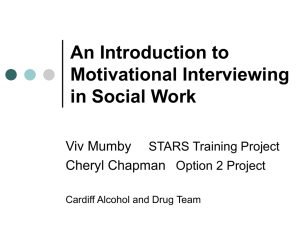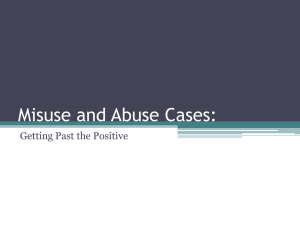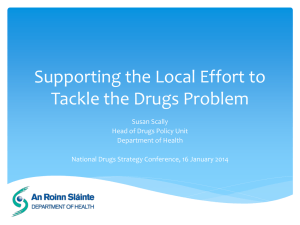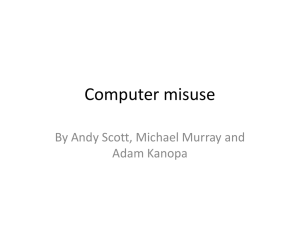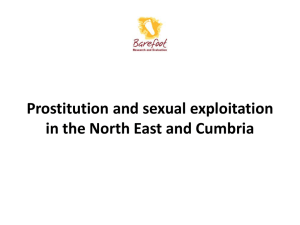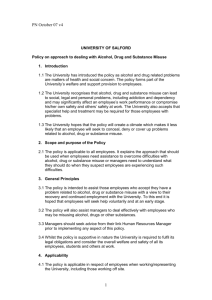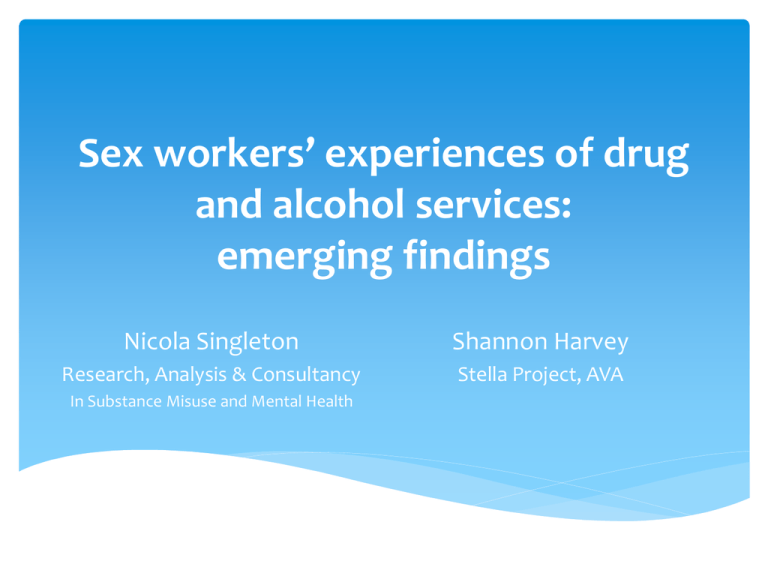
Sex workers’ experiences of drug
and alcohol services:
emerging findings
Nicola Singleton
Shannon Harvey
Research, Analysis & Consultancy
Stella Project, AVA
In Substance Misuse and Mental Health
Multi-component research project
Funded by Pilgrim Trust
Developed by Drugscope in partnership with AVA
Presentation outline
Overview of project methods
Key Findings
Extent and nature of the relationship between substance
use and sex work
Service needs and barriers to use
Effective interventions – evidence from the literature
Current service provision
Potential recommendations – for discussion
Project components
Rapid evidence review – University of Greenwich
On-line survey of services (n=64)
Interviews with women with a history of substance
use problems and prostitution
Peer interviewers
19 semi-structured interviews
Two geographical areas
Service case studies (3 services)
Interviews with staff and service users
Site visits
Substance misuse and sex work
“…once you’re out there and you’re
doing what you’re doing… You need
drugs to stay sane, but to pay for the
drugs you need to carry on committing
“I’ve been raped, I’ve been beaten up, fucking
those offences, so to speak.”
punched theof
fuck
out of, tied
up with in street sex work
Asodomised,
high proportion
women
engaged
all about
and that, stripped“…Its
in the car
and the money even when I’m
havemeaarms
history
of substance
use
problems, particularly
notfucking
using drugs
thrown out in the middle of the
fieldsI still need to go out and buy
opiates
& crack
and
vice
versa.
stuff
and a McDonalds
or something ... Its
and having
to walk
home
and
knocking
on
having
something to show for at the end
someone’s door because youjust
can’t
just walk
Substance
and sex
are mutually reinforcing.
of the
week.”
home. misuse
How humiliating
can
itwork
get?”
“… it’s about getting and doing something,
Street drug markets andabout
the associating
sex worker
are often
with beats
people…”
intertwined.
Violence is a common experience and can be extreme.
But sex“I work
also provides
an independent
income
and a
had problems
with my ex-partner
and he broke my
leg
social network.
and I ended up in hospital and was in a bad way.”
Service needs
Support needs will vary over time ranging from basic support
and harm reduction services to recovery and exiting support.
Four broad types of needs:
Basic physical needs (eg food, clothing, sanitary products, shelter);
Mental/emotional needs (eg friendship, counselling, DV protection);
Health care needs (eg drug treatment, reproductive care, HIV/STI care;
general medical care);
Longer term needs (eg mailing address, NI number, Housing,
employment).
Barriers to service use
“Guilt,
my lifestyle
– how overwhelming
“…my shame,
ex-boyfriend
who sometimes
– well
it
is toon
change.
There’s
needget
toachange.”
we’re
and off.
WhenaI lot
tryIand
few days
Individual barriers
of the crack and the smack and just stick to the
methadone,
he’llquite
manipulate
toto
gosay
down
“You know I’m
worriedme
now
I’m
Self-esteem/beliefand
that
change
is
possible
up my old
behaviour..”
outtake
working…
again.
And the impact it will
it have on my son. I don’t want them
Partner
coming and taking my son off me.”
Children
Stigma (drug use & prostitution)
Service/institutional barriers
Hours of operation, long waits, long waiting lists,
problems with telephone systems
Trust & consistency of key-worker
Lack of integration of services
Geographical location of services
Effective interventions
Key factors identified
Out-reach/accessibility eg mobile services, drop-in
Evening opening hours
Involvement of peers eg as worker, mentors etc
Enhancement of standard programmes to meet specific needs of
these women
Integrated provision or strong case management to cater for all
needs eg mental health, substance use, economic opportunities, social
support
Child care provision
Women-only provision
Non-judgemental approach
Current service provision
Outreach and accessibility
In the past we have done in-reach or have had
project working with them such as [the local
sex work project] had specific workers who
were funded to go and work more closely
with the women. They would also provide
drop-ins. We would also have the outreach
van that used to provide condoms, needle
exchange and things like that.
- Substance misuse service
provision
at a
¾Drop-in
(69%)
offered
drop-in and/or open access services
different venue to main
services.
BUT only
half provided this in a format likely to
- Substance misuse
specifically
service support women involved in street-based
prostitution
52% had evening opening hours
17 substance misuse services, 8 sex work projects, 1 sexual
Not open
regularly in evenings,
health
however evening appointments
are available and are offered if a
woman is unable to/ struggling
to access the service during
opening hours. Some evening
outreach sessions provided.
- Sex work project
outreach weekdays,
52% had an outreach van or similar Evening
currently expanding to
cover early morning &
38% used a location close to the area used
for
soliciting
weekends.
- Sex work project
30% conducted outreach in prisons
Enhancement of standard programmes
We are a drug treatment agency so our
approach is always going to engage
women with drug treatment… but we
would also recognise that the woman’s
drug issues and sex-working will be
interlinked. Substance misuse is never
just about taking drugs, and to help
somebody exit or what you would call
recovery is about other factors too such
as housing, health, what people are doing
with their health, how they are sourcing
their money.
- Substance misuse service, West
Midlands
Although we do not provide an
advertised specialist service around
sexual violence or domestic violence,
we provide initial support and
assessment to specialist services. In
reality women frequently do not engage
straight away with specialist services,
we therefore frequently provide
support around these issues as well as
accompanying women to specialist
services.
- Sex work project
Involvement of peers
We have found that most women
using our substance misuse services
We would refer to
in our organisation frequently do not
providers who
want to openly disclose their
offer peer support.
involvement in sex work with other
- Drug service
One of the biggest advantages of
this users, which therefore has an
service
place is the support women giveimpact
each on being able to provide peer
other, you are all part of a group andled services for sex workers.
you’re all sharing, you are all supporting - Sex work project
each other, friendships are made. Quite
often, very positive relationships are built,
peer support & mentoring is massive, and
Peer support brings
I have seen it as a positive and negative. I
I think (substance misuse services) miss
commonality, so the immense
have had concerns about the sometimes
out on all that.
shame many women feel is
lack of training and supervision of peers
- Sex
Midlands
broken down a bit because
it'swork project, Westand
a lack of stability and distance from
shared amongst peers.
the peer’s own issues-can be detrimental
Women can bring their
to both parties. Sometimes there is a
experiences and feel valued,
hurry to involve women who are doing
and accepted and not alone.
well into becoming peers; sometimes this
- Drug service
can lead to a relapse or collusion.
- Drug service
Women-only space
As soon as you start getting better, everyone looks
attractive… and if someone is flirting with you and
your self-esteem is low, you’ll get drawn into
probably the wrong kind of relationships. Because I
did that, I was 8 months sober, met someone who
was still drinking, who wasn’t quite far into
recovery as I was, and ended up doing it with him.
So a women’s group is a good thing to have
because you can get women’s opinions in as well…
men are different from women obviously,
biologically. We are also socially in a different world.
- Women’s group leader, peer-led recovery project,
Yorkshire
Women-only space was not common
42% offered session times that were women-only
28% offered session times that were only for women
We create this big space and we provide lunch,
in sitprostitution
andinvolved
people all sit here,
around the table and
Women’s
involvement
with the women. That
is important, keeping in
no service provision
eat lunch, staff are in here with the women, eat
Only 1 service had a woman on their board of treetess
with experiences of prostitution and drug use
Only 4 employ these women as staff
28% have them as volunteers
58% consult them through service user groups
23% admit that these women are not involved in any way
in design, development or delivery or their services
hierarchy that’s what we are trying to create,
women in this together anyone could be in each
other shoes, it does not make any difference
you know, nobody knows if you are a woman
that’s just come out of prison or a sex-worker,
nobody knows if you’re under the mental health
team we are just women and we are just
together in one space and it doesn’t matter.
- Sex work project, West midlands
Children
Women need to feel safe; they need to feel
that they have their own space that is their
space. Most of our women have experienced
some sort of sexual abuse so it’s important
to offer them their own space. If you think
about it especially in probation services
where women make up only 3% of the total
number, and they have to sit in those waiting
rooms, with all these men especially if you
have a child in tow, in terms of space, for the
children they have nothing, no toys for the
kids, it’s all bars and black and white.
92% said child contact issues were important or very
important for women they worked with
91% said child protection concerns were important or
very important
BUT only 29% provide a service in relation to children
and/or pregnancy issues
Creche available for
children under 5 for
women attending
structured day care /
appointments
- Sex work project
- Sex work project
Integrated provision
We have [two drug services],
because they are independent, they
tend to be away a lot and they just
don’t seem that open to working
together, I don’t know if they see it
as competition, there just seems to
be barriers.
- Sex work project, West Midlands
What I noticed is that our workers and the [local
sex work project] workers, do work really
closely together when they are working on a
case and they are really flexible about where is
the best place to see that person rather than
having fixed ideas of oh it needs to be here.
Another issues is time – most women can only
come in evenings, whereas our workers are here
from the morning so it’s about finding that
middle ground.
- Substance misuse service , Yorkshire
Current policy landscape
Prostitution Strategy (2006)
the first step must be ‘to set them free from the drug addiction that
constantly forces them back onto the street’
‘this is a particularly vulnerable group of problematic drug users due to
their need to finance their drug use, and often that of their partners,
through prostitution’
Drug policy (2010)
No mention of the words ‘prostitution’, ‘woman’, ‘women’ or ‘girl’ in
document.
Call to End Violence Against Women & Girls
National Ugly Mugs scheme, 12 month pilot July 2012 – July 2013
Research (through embassies) on international best practice
Human trafficking – the Government Strategy 2011
Troubled families
Potential recommendations
Where next?
Increasing the policy focus.
Guidance for commissioners
Best practice guidance for services
Training for practitioners
Exploration of diversity of relationship between drug
use and sex work and of different types of sex work.
Thank you
Questions?

